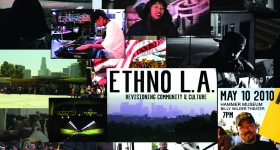Originally posted at New America Media.
Thanks to the Daily Show with Jon Stewart, Aasif Mandvi is perhaps the most recognizable desi face on screen today. But long before he became a “foreign-looking correspondent,” Mandvi starred in films like Ismail Merchant’s The Mystic Masseur. Even when he was still a relative unknown, he won awards for his one-person show Sakina’s Restaurant. In that play Mandvi plays all the characters, sometimes with the help of a scarf, a neck tie, or an accent. One character, Azgi, works at the restaurant, unsure of his English, nervous about saying much more than “yes, yes, yes.” The owner Hakim tells his Americanized daughter Sakina he is slaving away so she can grow up in the richest country in the world.
Many of these characters, or shades of them, appear in the new film, Today’s Special, which opened the 28th San Francisco International Asian American Film Festival this March and opens in theaters Nov. 19. The film is co-written by Mandvi and directed by David Kaplan. Mandvi spoke with India Currents about Today’s Special and other things off the menu.
What’s the connection between Today’s Special and the one-person play Sakina’s Restaurant you did years ago?
It’s an inspiration point. The characters are very different. We expanded the ideas but there is the general concept of food and a love story. So there is a thematic connection. It was more than 10 years ago that Sakina’s came into being. At that time I was trying to get seen and noticed. I didn’t like doing stand-up so I started writing characters. Since then I have been developing this. It probably took 8-9 years for this film to be made.
Why did you decide the time was right to do a film with Indian food at its center?
I was part of a sketch comedy group called The Associates. Jon Bines was also a comedy writer and food critic for New York Press. We got together to write a movie about Indian food. It seemed like a really good idea.
Did it feel like it would be easier to get it funded since everyone likes food even if they don’t always like immigrants who make the food?
Not really. The reality is that in the mainstream, Indian food still a pretty niche area. It didn’t make much difference to the funding. Most of our funding came from private equity anyway. We never changed our story.
It was hard to raise the money. We raised and lost it a couple of times. But that is the reality of independent film in this country. With Indians it’s harder.
Did your Daily Show profile help?
Yes it did. Sure, investors are more aware. We were able to get Naseeruddin Shah. That made some difference within the desi community. In fact the investors we got ended up being from the desi community.
Really? I thought desi community was quite hard to raise money from.
That is true. When we trying to raise $75,000 for Sakina’s Restaurant, we couldn’t. I knew people whose net worth was 50 million dollars who wrote us 50 dollar checks. But desis do invest in relationships. So it came from friends and brothers who got tired of hearing us go on and on about this film.
What was your relationship with Indian food growing up?
I ate it. (Laughs) My mother made it. It was part of my childhood. It is still my comfort food. Food is a symbol of home, family, first memory, and childhood. I am not a cook or chef. I went to school like all other kids with peanut butter and jelly sandwiches. But Indian food was definitely part of my upbringing.
Did you worry that centering the script around food would sort of exoticize the food?
It is a story about Samir’s journey as a character. I wanted to talk about an integration of his culture and the cuisine is a representation of that. Food is a symbol and we tried to stay true to that. I hope it is not exoticizing. Samir’s embracing the food and being willing to cook it is more important than the food itself.
Was it hard to write for yourself as a character?
It was hard. I found I gave all the good lines to everyone else. As a writer you create characters and you get left behind. The character of Akbar (the cab driver-turned-chef played by Naseeruddin Shah) and mine are almost polar opposites. Samir wants to go to France and ends up in an Indian world. Indian cooking is often like India itself—a little structure-less. Samir is uptight and he has to loosen up. In a way he has to learn to be Indian. I think that the way to loosen up is to integrate and take culture not as a book of rules or a dogma. The only way Samir can find who he is, is to go back and integrate his roots. You see that all the time in our culture.
You are neither brown nor white. Samir does not know his identity. In a sense it is a classic immigration story.
What kind of neighborhood did you grow up in?
I grew up in England and the United States. Most of my friends were middle-class white kids. For a long time I grew up thinking I was a white kid. The only Indians I knew were the children of my parents’ friends. After Sakina’s Restaurant I was suddenly meeting all these people who showed up to see the play who looked like me. It was really a case of if-you-build-it, they-will-come. In my thirties I started to have desi friends I had chosen—as part of my own family of friends. That was my integration.
I was interested that the film really focused on the men. The father and son, as well as the regulars at the restaurant.
It ended up as a father and son story. That’s where I needed to go. Kerry (Samir’s love interest) was a larger character in the original script. That got trimmed a great deal. There was also more of Madhur Jaffrey (as the mother). Ultimately David Kaplan(the director) decided the real hook was the father and son story. The strongest piece was about wanting approval from Hakim (the father) and finding Akbar as the surrogate. It is a story about manhood. But it’s a coming-of-age story about a guy in his 30s, not in his 20s. Often a character becomes a man in his 20s. An immigrant character spends a great deal of his twenties waffling, with no model for true self.
What was it like working with an acting legend like Naseeruddin Shah?
I got him the script. He read it and called us and said he didn’t know what role he would play. I said Akbar. He was like, “Who is that?” We realized he had read the wrong script! When he finally read the script, he thought it was great. Scheduling was the real problem, just to find two weeks he was free. He was a real trooper and slummed with us. I have also worked with Om Puri.
What’s great with these guys is they really just trust themselves. He is not over-thinking. When you do 50 movies a year there is no time to over-think. He came up with the look of Akbar. I wanted him much more Indian and wear a lungi. He showed up looking like Al Pacino.
Madhur Jaffrey plays your mother on screen. But she is about the only major character who is never seen cooking! (Madhur Jaffrey is a well known chef and cookbook writer) What’s with that? Did you at least have her as a food consultant?
We did not want to exploit her cooking. We hired her as an actress. We did have a scene with her making desserts that got cut. But she was not involved with food. She did not want to do double duty. Anyway we could not afford her as a food consultant. (Laughs)
Which would you say was your breakthrough—Mystic Masseur or The Daily Show?
I was proud of Mystic Masseur. But it was a little film. It didn’t hit the consciousness deeply. The Daily Show is a pop culture phenomenon.
How did you get the gig?
I just auditioned for it. They didn’t discover me in some stand-up club. They had written a role for a Middle East correspondent. I auditioned. It was supposed to be a one-off. Jon hired me and they kept calling me back. And finally gave me a real job.
What is it like to keep up the persona of a faux journalist?
It’s a weird hybrid. It’s like no other job I have had or will ever have. It’s a hybrid of journalist, actor, comedian—a weird mongrel. It’s not stand up. It’s more like an acting gig. It’s also a writing gig. But I do find it weird that I have a real office. I mean what actor has a real office?
Is it confusing to be Aasif Mandvi playing a character named Aasif Mandvi?
I play a character who is a journalist on a fake news show. He is smarter than I am, and dresses better than me. The character just happens to have my name. People expect me to talk like him but Harrison Ford is not Indiana Jones. It is initially confusing. I thought I had to be me. But even Jon Stewart is not the Jon Stewart walking around in the real world.
Your next role is in M. Knight Shyamalan’s movie The Last Airbender.
That is next. I am also pitching a TV show—a half-hour comedy which would star me as a dysfunctional self-help guru. I am excited about that. I also want to do a book of essays about being an immigrant kid and living in that space between cultures.
And what can you cook? What’s your special?
I can make anything that has eggs. Oh and great cocktails.









Comments